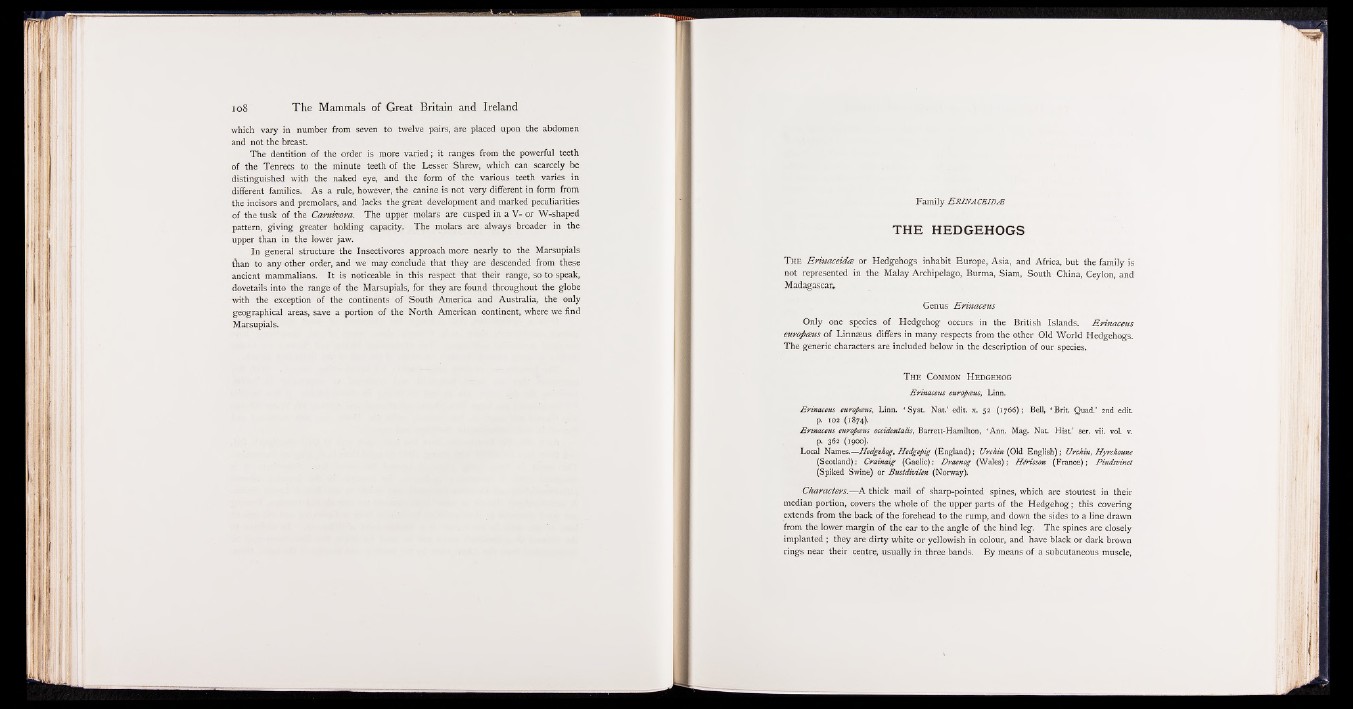
which vary in number from seven to twelve pairs, are placed upon the abdomen
and not the breast.
The dentition of the order is more varied ; it ranges from the powerful teeth
of the Tenrecs to the minute teeth of the Lesser Shrew, which can scarcely be
distinguished with the naked eye, and the form of the various teeth varies in
different families. As a rule, however, the canine is not very different in form from
the incisors and premolars, and lacks the great development and marked peculiarities
of the tusk of the Carnivora. The upper molars are cusped in a V- or W-shaped
pattern, giving greater holding capacity. The molars are always broader in the
upper than in the lower jaw.
In general structure the Insectivores approach more nearly to the Marsupials
than to any other order, and we may conclude that they are descended from these
ancient mammalians. It is noticeable in this respect that their range, so to speak,
dovetails into the range of the Marsupials, for they are found throughout the globe
with the exception of the continents of South America and Australia, the only
geographical areas, save a portion of the North American continent, where we find
Marsupials.
Family E rin aceidæ
THE HEDGEHOGS
T h e Erinaceidce or Hedgehogs inhabit Europe, Asia, and Africa, but the family is
not represented in the Malay Archipelago, Burma, Siam, South China, Ceylon, and
Madagascar
Genus Erinaceus
Only one species of Hedgehog occurs in the British Islands. Erinaceus
europceus of Linnaeus differs in many respects from the other Old World Hedgehogs.
The generic characters are included below in the description of our species.
T h e C o m m o n H e d g e h o g
Erinaceus europceus, Linn.
Erinaceus europceus, Linn. * Syst. Nat.’ edit x. 52 (1766); Bell, ‘ Brit. Quad.’ 2nd edit
p. 102 (1874).
Erinaceus europceus occidentalis, Barrett-Hamilton, ‘ Ann. Mag. Nat. Hist.’ ser. vii. vol. v.
p. 362 (1900).
Local Names.— Hedgehog, Hedgepig (England) ; Urchin (Old English) ; Urchin, Hyrchoune
(Scotland) ; Crainaig (Gaelic) ; Draenog (Wales) ; Hérisson (France) ; Pindsvinet
(Spiked Swine) or Bustdivilen (Norway).
Characters.— A thick mail of sharp-pointed spines, which are stoutest in their
median portion, covers the whole of the upper parts of the Hedgehog ; this covering
extends from the back of the forehead to the rump, and down the sides to a line drawn
from the lower margin of the ear to the angle of the hind leg. The spines are closely
implanted ; they are dirty white or yellowish in colour, and have black or dark brown
rings near their centre, usually in three bands. By means of a subcutaneous muscle,